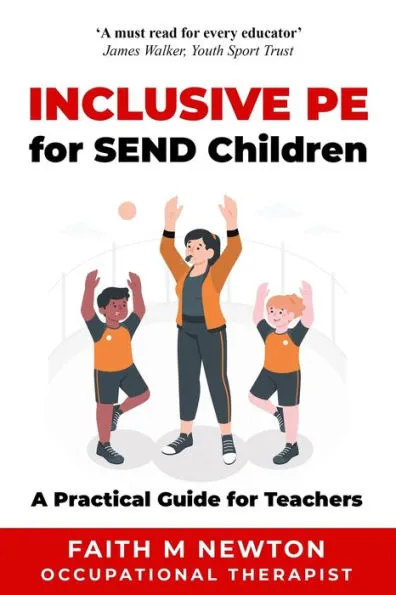
Book Review by Lee Sullivan
‘Inclusive PE for SEND Children’ by Faith M. Newton is an important exploration of a much needed topic within physical education (PE). In this illuminating book, Newton delves deep into the world of inclusive physical education (PE) and offers a comprehensive guide for those providing children with special educational needs and disabilities (SEND) the opportunity to engage in meaningful Primary PE.
From the very beginning, it is evident that Newton is not merely an Occupational Therapist but also a loving parent of a child with additional needs and a passionate advocate for positive experiences in PE for all children with SEND.
Section 1 – Starting Points
‘Inclusive PE for SEND Children’ is not just an informative read; it’s a call to action. Newton challenges us to consider our own PE experiences and consider whether that impacts how we might feel about or even how we deliver PE now. Through insightful examples of teachers perceptions towards delivering PE and a useful self-assessment quiz, Newton inspires the reader, no matter their past experiences of PE, we can greatly impact the experiences of all children in PE.
Newton moves onto exploring the starting points of the students, considering the interests of the students, the parental influences and the special needs that could be a barrier to participation for some. An honest and topical exploration of the starting point of the school will resonate with many, especially the marginalisation of PE and the increase in outsourcing.
The part of section 1 that I found the most beneficial focused on the key terminology and descriptions of what inclusion actually meant.
Newton goes beyond the dictionary definition of inclusion ‘giving equal access to opportunities to people who would otherwise be excluded or marginalised’ (page 40), to liken it more to ‘a sense of belonging’ and ‘being included within a group’ (page 41). Highlighting the importance of creating a safe space with carefully constructed opportunities for social interactions, Newton shares a number of stories from other parents whose child experienced a feeling of being left out or unwanted in PE lessons.
My favourite definition for inclusive PE provided was; ‘Inclusive PE allows children to experience the benefits of movements without barriers to participation,’ (page 43). This something that we as physical educators wish for all children in our care.
Section 2 – A New Inclusive Model
Whilst focused on children with SEND, many aspects of this book can apply to all students. ‘Traditionally, PE has focused on competitive sports. Now it’s time to embrace a different, more inclusive model,’ (page 57). Newton presents a compelling argument as to why there is a need for a new PE model, exploring the negative impacts that the exclusionary and elitist port eavy model can have on young people.
Newton goes on to provide useful advice and strategies on how to implement a more inclusive model.

Newton then discusses two important challenges in PE for children with SEND that are close to my heart, the use of changing rooms and dodgeball.
When reviewing the challenges that changing rooms present, Newton identifies the physical, sensory, communication and interaction, cognitive and social, emotion and mental demands that changing for PE can present. She provides a similar argument for the use of dodgeball in PE reviewing the complexity of what many consider to be a simple activity.
Section 3 – Physical and Sensory Difficulties,
The book seamlessly transitions its focus towards a more intricate examination of specific special educational needs and disabilities. Newton masterfully delivers a comprehensive and easily digestible summary of SEND characteristics and requirements. It’s apparent that the book is designed to serve as an invaluable resource for educators facing the nuanced challenges presented by diverse student needs. In truth, the breadth and depth of the reviewed conditions and strategies contained within this book are too extensive to cover adequately in this brief review. Therefore, in this and the following chapters, I have summarised some of the key takeaways. Please note, far more information and strategies are found within the book.
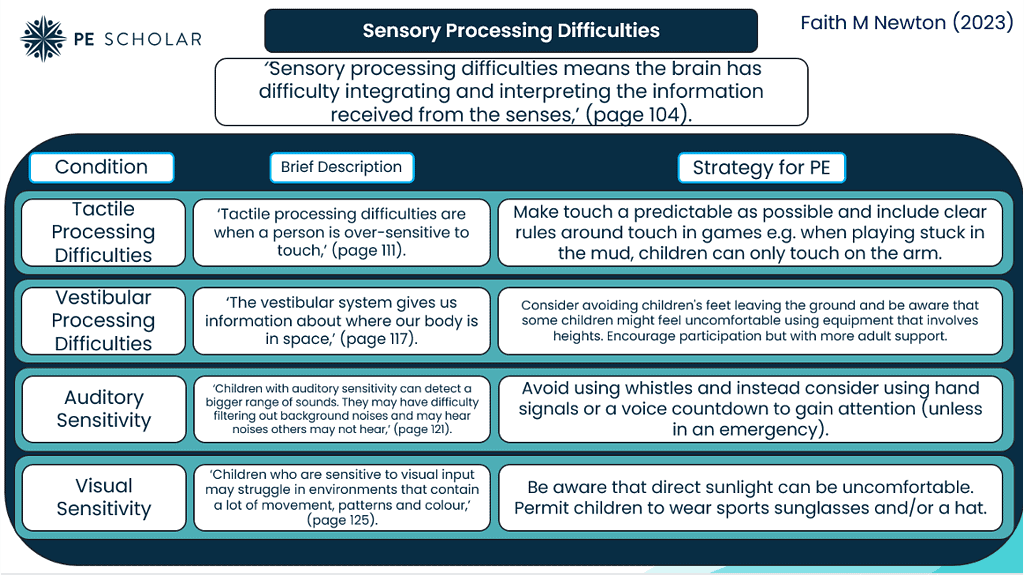
Section 4 – Physical and Sensory Difficulties
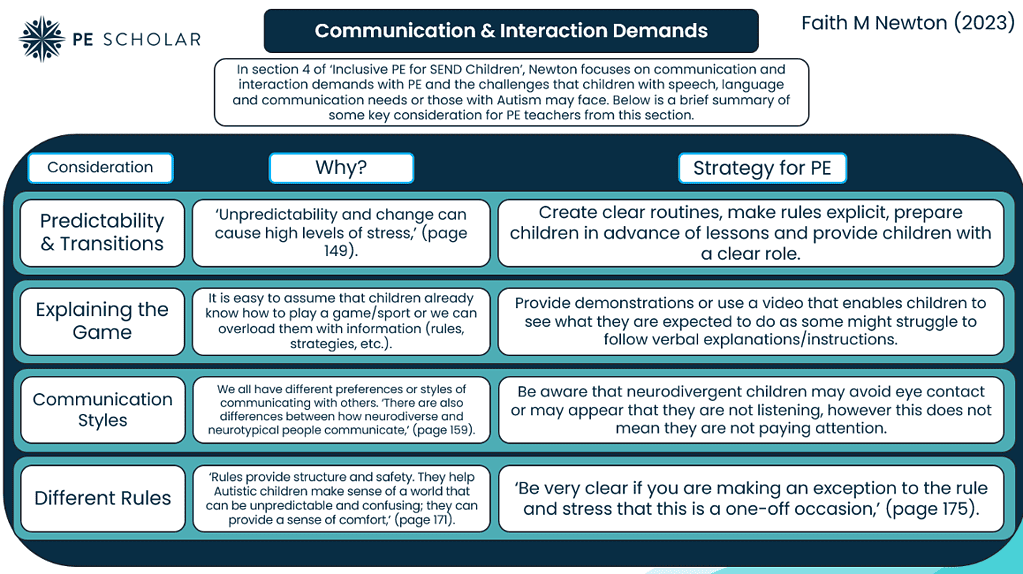
Section 5 – Cognitive and Learning Demands
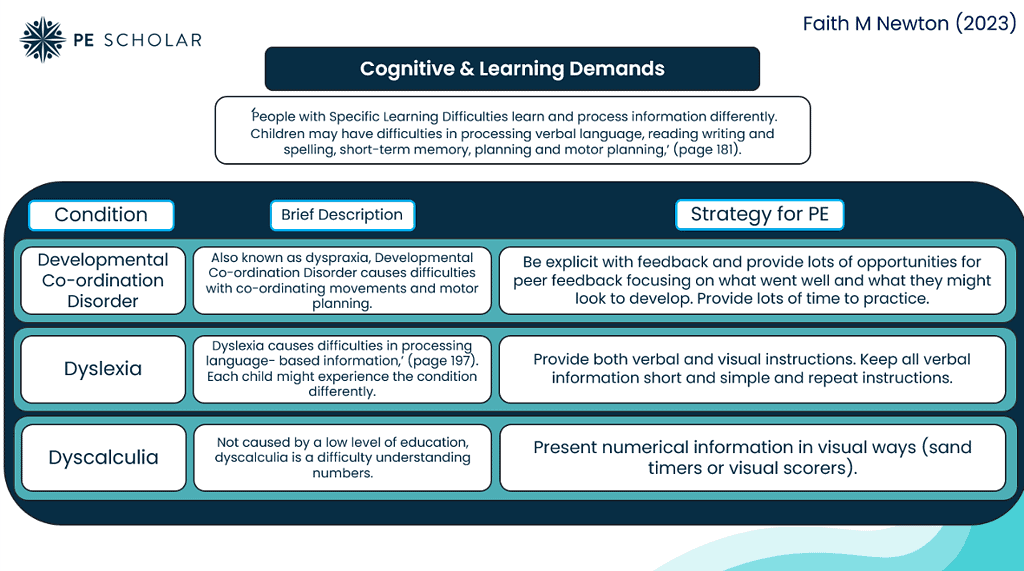
Section 6 – Social, Emotional and Mental Health Demands
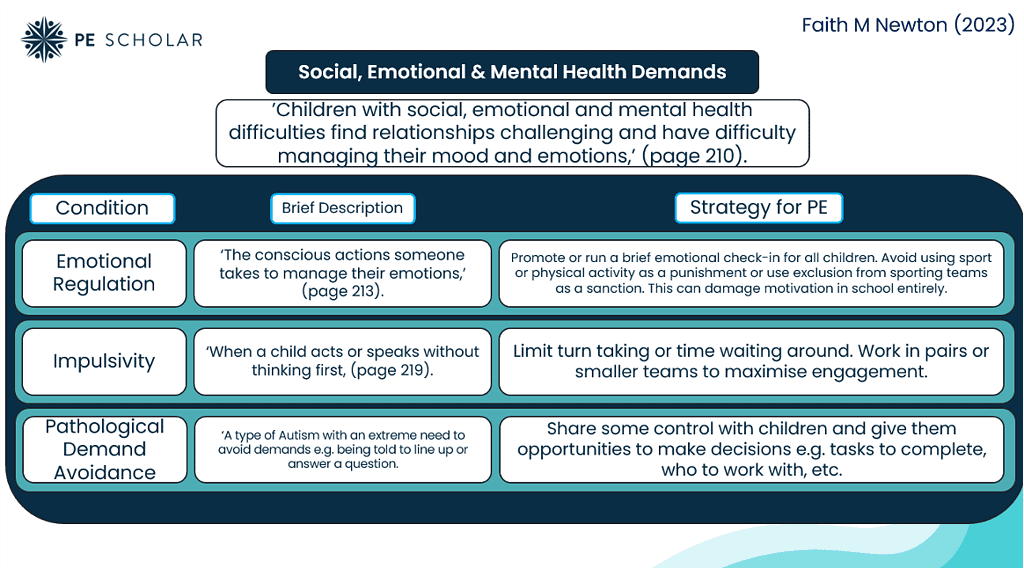
Section 7 – Next Steps
The final chapter of the book introduces us to the all-important next steps. But where would we even hope to begin with all of the information packed inside this book? Newton recognises not only the importance of implementing strategies presented, but also the challenges of doing so. She encourages readers to select one strategy at a time and have a go at it, repeat it and receive some feedback. The author reminds readers of her aim in writing the book, and indeed the aim that she wishes to instil in teachers, for all children with additional needs to flourish and feel included in PE.
Conclusion
Anticipating its role as a trusted companion for teachers, I foresee many educators turning to this book, particularly during critical moments. When a child with one of the conditions discussed enters our PE lessons, this book becomes our steadfast reference. Teachers will reach for it and uncover a treasure trove of practical insights and strategies tailored to each unique condition. The strategies suggested are actionable, sensitive, and tailored to the specific needs of the child.
Newton’s writing is both accessible and engaging, making this book a valuable resource for individuals with various levels of familiarity with the subject matter. She seamlessly combines her in-depth research with practical insights and real-life examples, creating a rich tapestry that brings the challenges and successes of inclusive PE to life.
The book’s approach is refreshingly holistic and emphasises the importance of fostering an environment that not only accommodates but celebrates the unique abilities and needs of SEND children. As a result, readers gain not only a theoretical understanding but also a practical toolkit for implementing inclusive PE programs in schools.
Here is a list of other book reviews you might want to check out:
Reviews by topic
Health and wellbeing
Happiness Factories: A success-driven approach to holistic Physical Education (podcast)
Time to RISE Up: Supporting Students’ Mental Health in Schools
Physical Education Pedagogies for Health
Inclusion and social justice
Inclusive PE for SEND Children podcast
Teaching Disabled Children in Physical Education
Pedagogies of Social Justice in Physical Education and Youth Sport
Pedagogy
Applying Models-based Practice in Physical Education
Perspectives on Game-Based Coaching
The Future of Teaching and the Myths That Hold it Back
Meaningful PE – an approach for teaching and learning
Threshold Concepts in Physical Education
The Spectrum of Teaching Styles in Physical Education and podcast
Reading lists
Also, don’t forget to take a look at these books published by Scholarly – indispensable additions to every PE teacher’s bookshelf.


[…] Newton, F. (2023) Inclusive PE for SEND Children. FB3 Publishing. Available Online: https://www.pescholar.com/insight/inclusive-pe-for-send-children/ […]
[…] Click here to read a review of Faith’s book, ‘Inclusive PE for SEND Children: a practical guide for teachers’ or purchase by clicking here. […]
[…] Inclusive PE for SEND Children book review […]
[…] Inclusive PE for SEND Children book review […]
[…] Inclusive PE for SEND Children and podcast […]